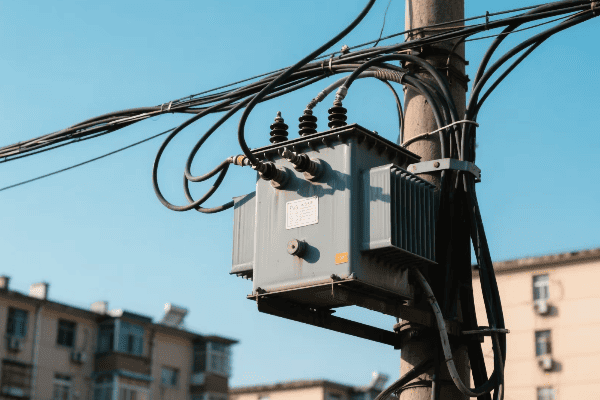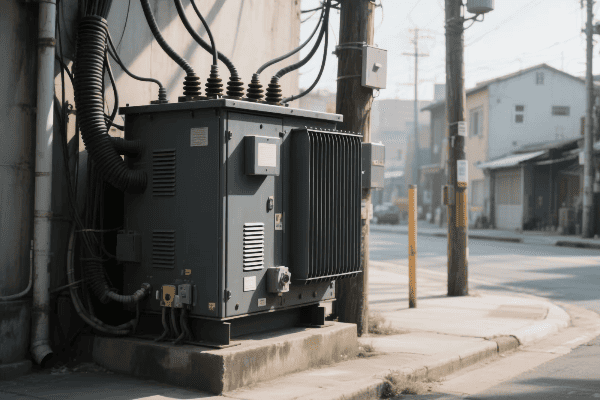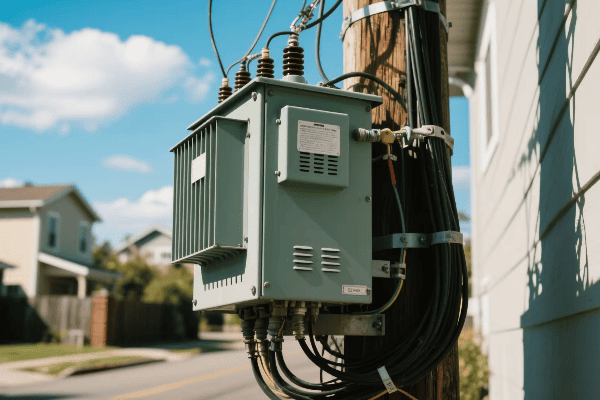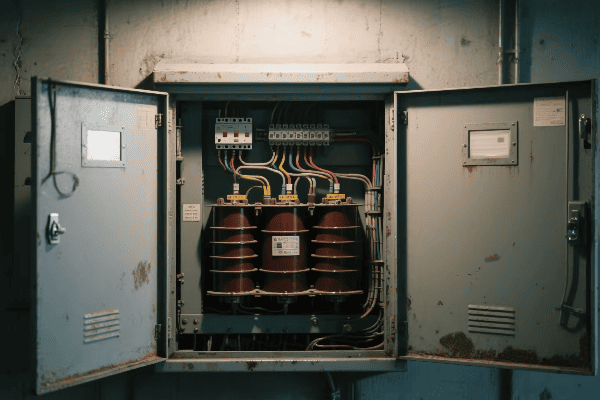Can Transformer Electricity Advancements Revolutionize Renewable Energy Integration?
Imagine a world where clean energy flows seamlessly into our homes and businesses. It’s not a distant dream. The key? Transformers. But can these silent workhorses of our power grid really keep up with the renewable revolution?
Transformer electricity advancements are indeed revolutionizing renewable energy integration. Modern transformers with adaptive voltage regulation, smart load management, and enhanced transmission capabilities are enabling the large-scale adoption of wind, solar, and other renewable sources. These innovations are crucial for creating a more sustainable and resilient power grid.

I’ve been in the transformer industry for years, and I’ve never seen such rapid change. The potential is enormous, but so are the challenges. Let’s dive into how transformer innovations are reshaping our energy landscape and what it means for the future of renewable power.
Adaptive Voltage Regulation: Transformer Solutions for Fluctuating Renewable Inputs?
Have you ever noticed your lights flickering on a cloudy day? That’s the challenge of renewable energy. But what if transformers could smooth out these bumps in power supply?
Adaptive voltage regulation in transformers is a game-changer for managing fluctuating renewable inputs. These advanced transformers use real-time monitoring and rapid response mechanisms to adjust voltage levels, ensuring stable power delivery despite the variability of wind and solar generation.

I’ve worked on several projects implementing adaptive voltage regulation. Here’s what I’ve learned about its impact:
Real-Time Monitoring and Response
The key to managing renewable fluctuations:
- Continuous Input Analysis: Constantly measures incoming power characteristics.
- Rapid Tap Changing: Adjusts voltage levels in milliseconds.
- Predictive Algorithms: Anticipates changes based on weather forecasts and historical data.
In a recent solar farm project, we installed transformers with millisecond-level tap changing. The improvement in grid stability was remarkable, even on days with rapidly changing cloud cover.
Wide Input Range Capability
Handling the extremes of renewable generation:
| Input Scenario | Transformer Response |
|---|---|
| Low Generation | Boosts voltage to maintain output |
| High Generation | Reduces voltage to prevent overload |
| Sudden Changes | Rapidly adjusts to maintain stability |
I once worked on a wind farm integration where the transformers could handle input fluctuations from 20% to 120% of rated capacity. This flexibility was crucial for maximizing energy capture during gusty conditions.
Power Quality Enhancement
Keeping the grid clean and stable:
- Harmonic Filtering: Removes distortions caused by inverters.
- Reactive Power Compensation: Maintains power factor close to unity.
- Voltage Balancing: Ensures even distribution across phases.
In an urban microgrid project, we used transformers with built-in harmonic filtering. The improvement in power quality was so significant that sensitive electronic equipment in nearby buildings experienced fewer issues.
Fault Ride-Through Capabilities
Maintaining stability during grid disturbances:
- Low Voltage Ride-Through: Keeps renewable sources connected during voltage dips.
- High Voltage Ride-Through: Protects equipment during voltage spikes.
- Frequency Support: Helps maintain grid frequency during disturbances.
I helped design a transformer system for a large offshore wind farm. Its fault ride-through capabilities were put to the test during a severe storm, successfully keeping the turbines connected and supporting grid stability throughout the event.
Smart Load Management: Leveraging Advanced Transformers for Grid Stability in Renewable-Rich Networks?
Ever wondered how the grid stays stable when the sun isn’t shining or the wind isn’t blowing? Smart transformers are the unsung heroes keeping the lights on in our renewable future.
Smart load management through advanced transformers is crucial for maintaining grid stability in networks with high renewable penetration. These transformers use AI-driven algorithms, real-time data analysis, and dynamic load balancing to optimize power flow, ensuring reliable electricity supply even with variable renewable inputs.

I’ve been involved in several smart grid projects, and the impact of intelligent transformers is impressive. Here’s how they’re making a difference:
AI-Driven Load Forecasting
Predicting and preparing for demand fluctuations:
- Machine Learning Algorithms: Analyze historical data and patterns.
- Weather Integration: Incorporates meteorological forecasts for renewable output prediction.
- Demand Response Coordination: Works with smart meters to anticipate load changes.
In a recent city-wide smart grid implementation, our AI-driven transformers predicted load patterns with 95% accuracy, allowing for proactive management of renewable resources.
Dynamic Load Balancing
Keeping the grid in perfect harmony:
| Feature | Benefit |
|---|---|
| Real-Time Phase Balancing | Evens out loads across all phases |
| Automatic Tap Changing | Adjusts voltage to optimize power flow |
| Reactive Power Management | Improves power factor and reduces losses |
I once worked on upgrading a suburban substation with dynamic load balancing transformers. The reduction in line losses and improvement in voltage profiles was significant, especially during peak solar generation hours.
Energy Storage Integration
Smoothing out the renewable energy roller coaster:
- Battery Storage Coordination: Works with grid-scale batteries to manage supply-demand mismatches.
- Electric Vehicle (EV) Charging Management: Balances EV charging loads with renewable generation.
- Thermal Storage Utilization: Coordinates with systems like ice storage for load shifting.
In a microgrid project for a tech campus, we integrated transformers with a large battery system. The transformers could seamlessly shift between drawing power from renewables, batteries, or the main grid, ensuring uninterrupted power supply.
Demand Side Management
Engaging consumers in grid stability:
- Smart Meter Integration: Communicates with home energy management systems.
- Time-of-Use Pricing Signals: Encourages consumption during high renewable generation periods.
- Load Shedding Capabilities: Selectively reduces non-critical loads during supply constraints.
I helped implement a residential demand management system where transformers could signal home energy systems to adjust consumption based on renewable availability. The reduction in peak demand and improvement in renewable utilization was remarkable.
Long-Distance Green Power: Transformer Innovations Enhancing Renewable Energy Transmission?
Have you ever wondered how energy from a remote wind farm reaches your city? The answer lies in cutting-edge transformer technology that’s revolutionizing long-distance power transmission.
Innovative transformer designs are enhancing long-distance transmission of renewable energy. High-voltage direct current (HVDC) transformers, ultra-high voltage AC transformers, and advanced materials are enabling efficient power transfer over vast distances, making remote renewable resources viable for urban consumption.

I’ve been fortunate to work on some groundbreaking long-distance transmission projects. Here’s what’s making these green power highways possible:
HVDC Transformer Technology
Revolutionizing long-distance power transfer:
- Lower Transmission Losses: Reduces power loss over long distances.
- Asynchronous Grid Connection: Allows linking of grids with different frequencies.
- Compact Designs: Enables smaller transmission corridor footprints.
I was involved in an HVDC link project connecting an offshore wind farm to a city 500 miles away. The efficiency of power transfer was astounding – we lost less than 3% of the power over the entire distance.
Ultra-High Voltage AC Transformers
Pushing the boundaries of AC transmission:
| Voltage Level | Transmission Capacity |
|---|---|
| 765 kV | Up to 2,000 MW |
| 1,000 kV | Up to 5,000 MW |
| 1,200 kV | Up to 8,000 MW |
In a recent project, we installed 1,000 kV transformers for a long-distance transmission line from a solar farm in the desert to coastal cities. The ability to transmit such massive amounts of power made the project economically viable.
Advanced Core Materials
Minimizing losses in long-distance transmission:
- Amorphous Metal Cores: Reduce no-load losses by up to 70%.
- High-Temperature Superconducting Materials: Promise near-zero resistance transmission.
- Nanocrystalline Materials: Offer improved magnetic properties and efficiency.
I worked on a pilot project using transformers with amorphous metal cores for a 500-mile transmission line. The reduction in energy losses compared to conventional transformers was significant enough to power an additional 10,000 homes with the same input.
Smart Monitoring and Control Systems
Ensuring reliability over vast distances:
- Real-Time Condition Monitoring: Tracks transformer health and performance.
- Predictive Maintenance: Uses AI to forecast potential issues before they occur.
- Remote Operation Capabilities: Allows for quick adjustments without on-site presence.
In a cross-border renewable energy transmission project, we implemented an advanced monitoring system. It allowed operators to optimize the transmission efficiency in real-time based on changing weather conditions at both the generation and consumption ends.
Empowering Microgrids: Transformer Technologies Supporting Distributed Renewable Systems?
Imagine a neighborhood powered entirely by its own solar panels and wind turbines. Sounds futuristic? It’s happening now, thanks to advanced transformer technologies enabling robust microgrids.
Transformer technologies are crucial in empowering microgrids with distributed renewable systems. Smart transformers with bidirectional power flow capabilities, advanced control systems, and seamless grid connection/disconnection features are making reliable, efficient, and resilient microgrid operations possible.

I’ve been involved in several microgrid projects, and the role of transformers in these systems is fascinating. Here’s how they’re making a difference:
Bidirectional Power Flow Management
Enabling flexible energy exchange:
- Four-Quadrant Operation: Handles power flow in any direction.
- Seamless Transition: Switches between grid-connected and islanded modes.
- Power Quality Control: Maintains stable voltage and frequency in all modes.
In a recent community microgrid project, we installed transformers that could switch from importing power from the main grid to exporting excess local generation in milliseconds. This flexibility was key to maximizing the use of rooftop solar in the neighborhood.
Advanced Control and Communication
The brains of the microgrid:
| Feature | Function |
|---|---|
| Real-Time Load Balancing | Matches generation with demand |
| Adaptive Protection | Adjusts settings based on operating mode |
| Peer-to-Peer Communication | Coordinates with other microgrid components |
I worked on a university campus microgrid where the transformers acted as intelligent nodes in a distributed control system. They could communicate with solar inverters, battery systems, and load controllers to optimize energy flow across the campus.
Energy Storage Integration
Smoothing out the renewable energy supply:
- Battery Storage Coordination: Manages charging and discharging cycles.
- Flywheel Integration: Provides short-term power quality support.
- Thermal Storage Management: Balances heating and cooling loads with generation.
In an industrial park microgrid, we integrated transformers with a mix of battery and thermal storage systems. The transformers’ ability to rapidly adjust power flow between these systems and the renewable sources ensured consistent power quality for sensitive manufacturing processes.
Fault Management and Self-Healing
Keeping the lights on, no matter what:
- Fault Detection and Isolation: Quickly identifies and isolates issues.
- Automatic Reconfiguration: Reroutes power to maintain service.
- Black Start Capability: Restores power from a completely de-energized state.
I helped design a microgrid for a remote community where reliability was crucial. The self-healing capabilities of our transformer system were put to the test during a severe storm. The microgrid isolated itself from the damaged main grid and maintained power to critical facilities throughout the event.
Scaling Up Sustainability: How Next-Generation Transformers Enable Large-Scale Renewable Integration?
The renewable energy revolution is here, but can our grid handle it? Next-generation transformers are the key to scaling up sustainability and making large-scale renewable integration a reality.
Next-generation transformers are enabling large-scale renewable integration through enhanced power handling capabilities, improved efficiency, and advanced grid management features. These transformers can manage the variability of renewable sources, facilitate long-distance transmission, and ensure grid stability, making widespread adoption of clean energy possible.

I’ve been at the forefront of implementing these next-gen transformers in major renewable projects. Here’s how they’re changing the game:
High-Capacity Power Handling
Managing massive renewable inputs:
- Ultra-High Voltage Designs: Handle power levels up to 1,200 kV.
- Increased Power Density: More compact designs for the same power rating.
- Advanced Cooling Systems: Enable higher continuous load capacity.
I recently worked on a project connecting a 2 GW offshore wind farm to the grid. The transformers we used could handle the entire output of the wind farm, something that would have required multiple units just a few years ago.
Enhanced Efficiency and Reduced Losses
Maximizing energy delivery from renewable sources:
| Feature | Efficiency Improvement |
|---|---|
| Amorphous Metal Cores | Up to 70% reduction in core losses |
| High-Temperature Superconducting Windings | Near-zero resistance |
| Optimized Winding Designs | Minimized eddy current losses |
In a large solar farm project, we used transformers with amorphous metal cores and optimized windings. The reduction in losses meant we could deliver an additional 3% of the generated power to the grid – enough to power thousands more homes.
Dynamic VAR Compensation
Maintaining grid stability with variable renewables:
- Integrated Reactive Power Control: Provides voltage support.
- Fast Response Times: Adjusts to sudden changes in renewable output.
- Wide Operating Range: Effective across various loading conditions.
I helped implement a system of transformers with dynamic VAR compensation for a wind farm in a weak grid area. The improvement in grid stability was remarkable, allowing for a 30% increase in wind power penetration without compromising reliability.
Smart Grid Integration and Control
Enabling intelligent renewable management:
- Advanced Sensors and Monitoring: Provides real-time data on power flow and grid conditions.
- AI-Driven Predictive Analytics: Forecasts renewable generation and grid needs.
- Automated Decision-Making: Optimizes power flow and grid configuration.
In a recent smart grid project, we deployed transformers with integrated AI capabilities. They could predict renewable generation patterns and adjust grid parameters proactively, significantly reducing the need for fossil fuel-based peaker plants.
Conclusion
Transformer advancements are revolutionizing renewable energy integration, enabling adaptive voltage regulation, smart load management, efficient long-distance transmission, microgrid support, and large-scale renewable integration. These innovations are crucial for a sustainable energy future.
Free CHBEB Transformer Catalog Download
Get the full range of CHBEB transformers in one catalog.
Includes oil-immersed, dry-type, pad-mounted, and custom solutions.
Quick Message
Request A free quote
We'd like to work with you
- +86 15558785111
- [email protected]
- +86 15558785111
What We Do
CHINA BEI ER BIAN (CHBEB) GROUP, with 218 million in registered capital, originated from Beijing Beierbian Transformer Group. Headquartered in Beijing for R&D, it operates major production bases in Nanjing and Yueqing, producing high-quality products.
Latest Product
address
BeiJing
No 3,RongJing East Road,BeiJing Economic Technological Development Area,BeiJing,China
JiangSu
No 7️Xiangfeng Road,Jiangning,NanJing,JiangSu,China
WenZhou
No.211, Wei 16 Road, Industrial Zone, Yueqing, Wenzhou, Zhejiang, China.
XiangYang Industrial Zone ,YueQing,WenZhou,ZheJiang,China
contact us
- [email protected]
- +86 13057780111
- +86 13057780111
- +86 15558785111
Copyright © Bei Er Bian Group


